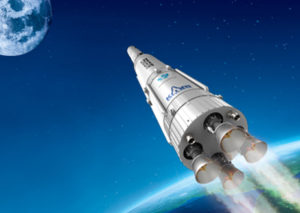
After a number of delays and starts, South Korea is finally pressing ahead with the development of its second Korean Space Launch Vehicle (KSLV-II) as well as its lunar exploration programme.
The KSLV-II is a three-stage launch vehicle which will put a 1.5-ton multipurpose satellite into low orbit at 600 to 800 kilometers (372 to 497 miles) above the Earth. The first-stage booster will consist of four 75-ton fuel engines, and the second stage will be made up of a single 75-ton engine. The third stage will come with a 7-ton liquid engine.
This liquid fuel engine, designed and developed by Korean scientists in partnership with local companies, will be the focal point of the KSLV-II, which the country is planning to launch into low Earth orbit in February and October 2021. Nearly 300 scientists at the Korea Aerospace Research Institute (KARI) have been working on the engine, which uses kerosene and liquid oxygen. It has been tested more than 75 times for a total of 5,420 minutes under varying conditions, and testing will continue until it is attached to a launch vehicle and sent into space in 2021. A test flight for the engine in the form of a two-stage launch vehicle is scheduled for October.
Korea launched its KSLV-I rocket in January 2013, after two failures and several delays. It carried the 100-kilogram Science and Technology Satellite 2C (STSAT-2C) into orbit. Although the event was lauded as the first successful launch of a Korean-made space vehicle, the two-stage vehicle actually used Russian technologies for its first-stage booster. The KSLV-II, however, is fully developed with Korean technologies.
“We began developing the KSLV-II with the goal of securing our own launch vehicle based on the experience with the KSLV-I,” said Park Jeong-joo, director of the Naro Space Centre, in a report in Korea Joongang Daily. “But we had to overcome a range of technological barriers, such as engine combustion instability, and we made numerous design and structural changes.”
Korea launched its first satellite, Uribyol-I, via Europe’s Ariane launch vehicle in 1992. Today, more than a dozen Korean satellites, with purposes spanning scientific research, telecommunications broadcasting, and meteorological, disaster and defence surveillance, are currently in orbit.
Although some experts believe Korea might lag behind in terms of launch vehicles compared to other Asian spacefaring countries, it is moving forward quickly in other directions.
Chang Young-keun, a professor of aerospace and mechanical engineering at the Korea Aerospace University, explained in the article in Korea Joongang Daily that not all economic powerhouses have space programmes. Further, as of 2016, Korea had the seventh-largest space budget in the world, at $671 million, according to Euroconsult.
In 2014, the Korean government greatly increased its space budget to 510.2 billion won ($472.6 million) and set the ambitious goal of sending a lander to the Moon, a feat already accomplished by Japan, China and India, by 2020.





